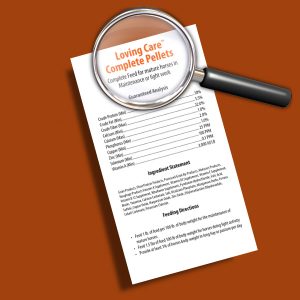
It’s on the Horse Feed Tag – Part 2
What’s in a name?
Feed manufacturers are required by law to put the name of a feed on each feed tag. The name should describe the type of feed contained in the bag. In many cases you may find a brand name and a descriptive name, for example, LovingCare™ complete pellets.
The creative brand name is a marketing tool meant to convey a message to the horse owner and make it easier for you to identify a specific brand of feed, while the descriptor gives you your first clue as to what type of feed is in the bag and which of your horses might benefit from the feed.
Commercial feeds are typically broken down into three categories, depending on how the feed is processed.
1) Textured feeds
Known throughout the horse world as “sweet feeds,” textured feeds contain a mix of grains, molasses, and a fortified pre-mix in the form of a pellet. The grains can be processed to increase digestibility. Crimped, cracked, rolled, flaked or micronized grains are available. Physical manipulation of the grains (crimping, cracking and rolling) increases the surface area available for enzyme reactions, which increase digestibility. Grains that are steam-flaked or micronized (cooked with dry heat) contain pre-digested starches and proteins that are easier for the horse to absorb in the small intestine. Typically, the more processed the grains are, the more expensive the feed is.
Textured feeds also contain a pre-mix pellet that includes the vitamins, minerals, and protein necessary to balance the nutrients in the feed. Additional ingredients such as yeast or fats can be added to increase digestibility and energy content. Textured feeds tend to be very palatable but some clever horses excel at sifting out the tastiest bits to eat and wasting the rest.
2) Processed concentrates
Processed feeds can be pelleted or extruded. They contain a mixture of grains, grain byproducts, and a fortified pre-mix. Some manufacturers will include other ingredients such as yeast or fats to increase palatability, digestibility, and energy content.
When pelleting a feed, the ingredients are chopped up, warmed with dry heat, and pushed through a pellet mill. Pellets come in many different sizes, from small to large. Horse people like pelleted feeds because they reduce the incidence of sorting. Larger pellets are easy to feed to horses that are living outside.
Extruded feeds are chopped up, cooked at temperatures upwards of 260° F, and puffed full of air (like dog food). Extrusion begins the breakdown of starches and proteins, making them more digestible. Fats are easily added during the extrusion process, allowing manufacturers to produce high-fat, high-energy feeds. One drawback to cooking the ingredients is that it deactivates the vitamins; up to 40% of the vitamin content can be lost, depending on cooking time and temperature. Feed manufacturers counter this issue by adding additional vitamins. The mineral content of the ingredients is not affected by cooking.
3) Complete feeds
Complete feeds contain both a concentrate portion made up of grains, grain byproducts and a pre-mix, plus a fiber source such as beet pulp, chopped alfalfa, rice hulls, or wheat middlings. Complete feeds are desirable when poor quality or limited forages (hay or pasture) are available. Older horses that have dental problems benefit from consuming complete feeds because the forage portion is easier to chew. Complete feeds do not supply the long-stemmed fiber that is found in pasture grass and hay. It is best to include some long-stemmed fiber in the diet, even when feeding a complete feed. Because they are so high in fiber, most complete feeds contain low amounts of energy. Hard keepers or older horses may need supplementation with an additional energy source such as a high-fat supplement in order to maintain optimal condition.
As you can see, the name on the feed tag gives you your first clues to what you will find when you open the bag and what type of horse a particular feed is formulated for. In the next part of the “It’s on the Feed Tag” series we will look at the Purpose Statement to find more clues.


